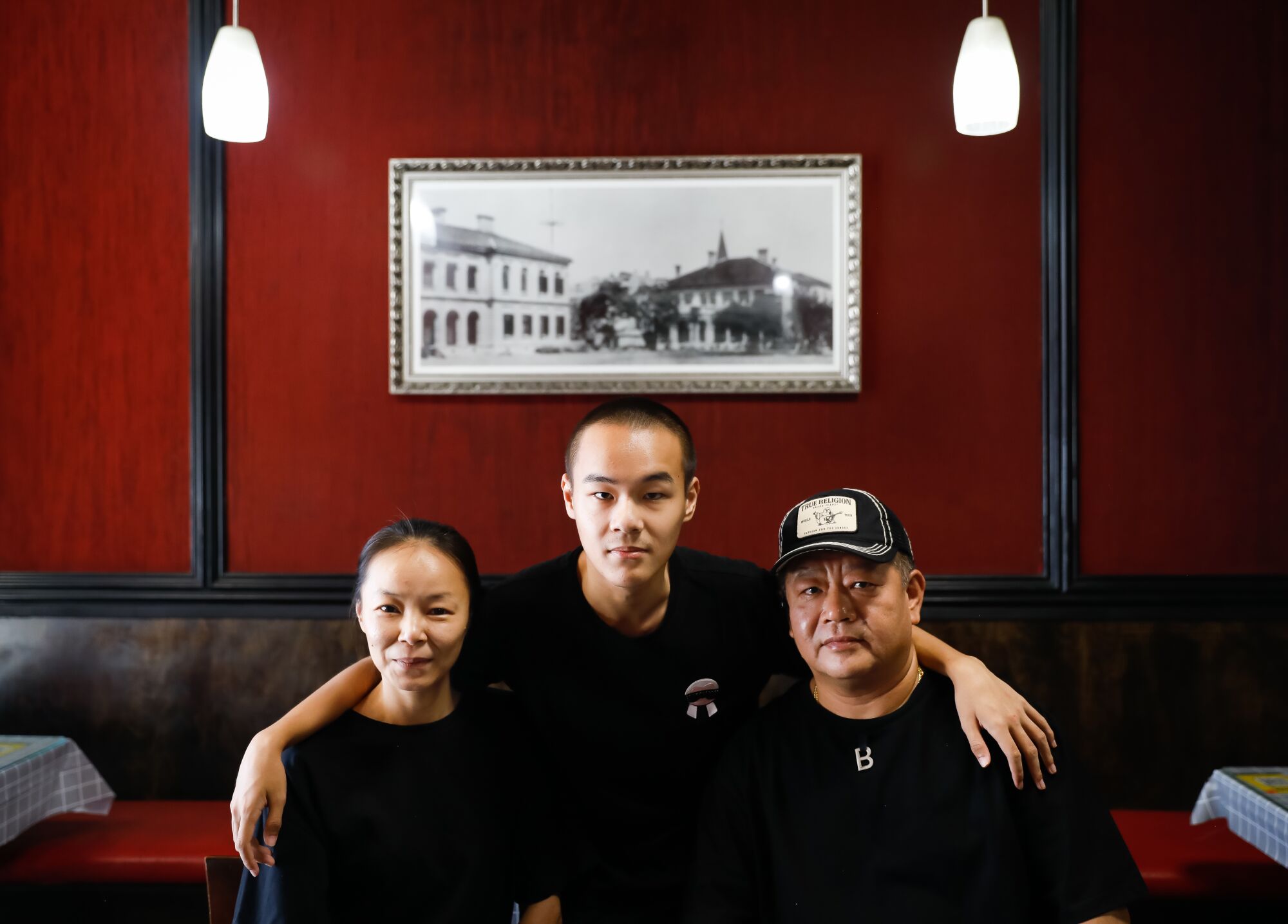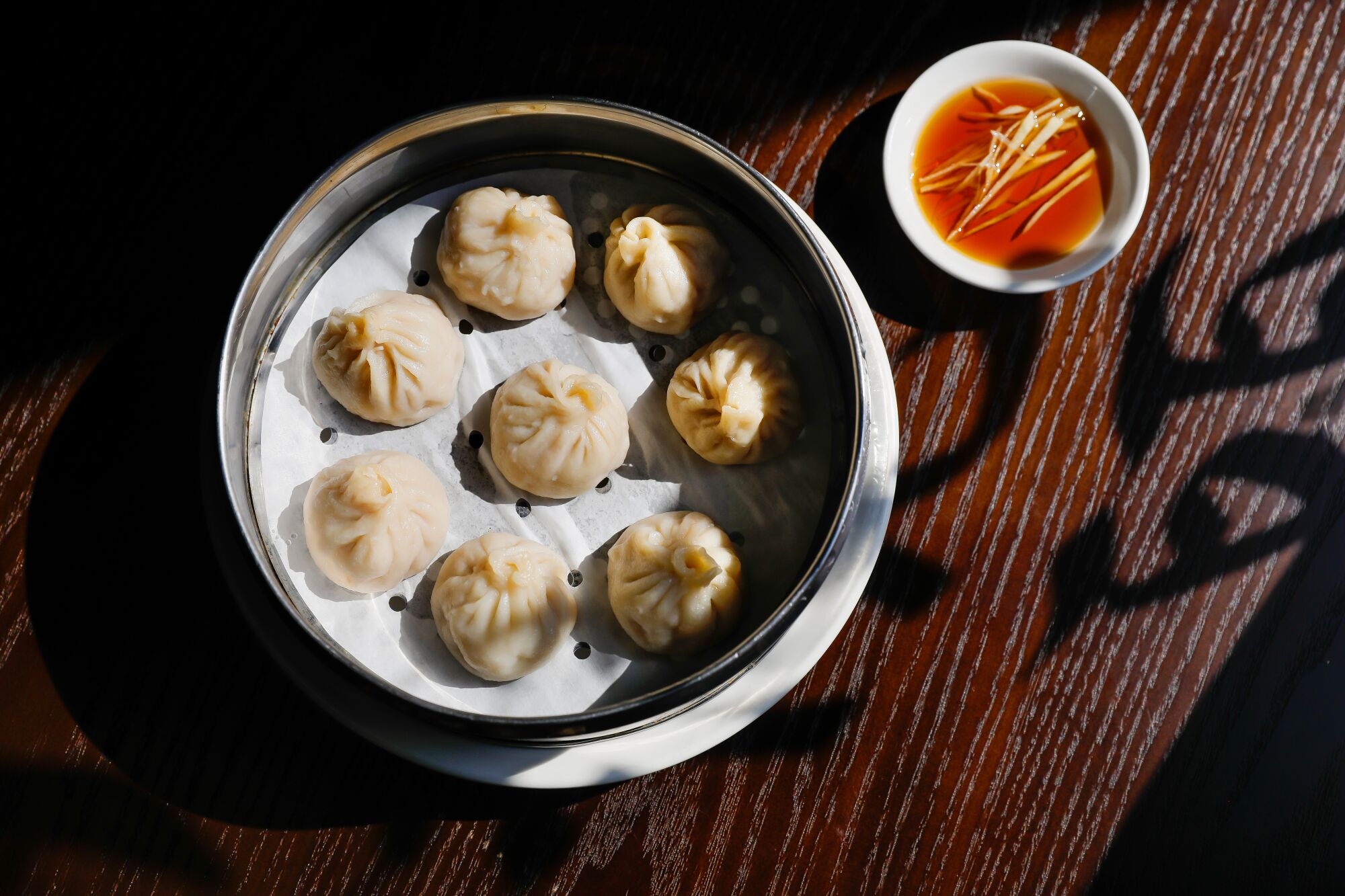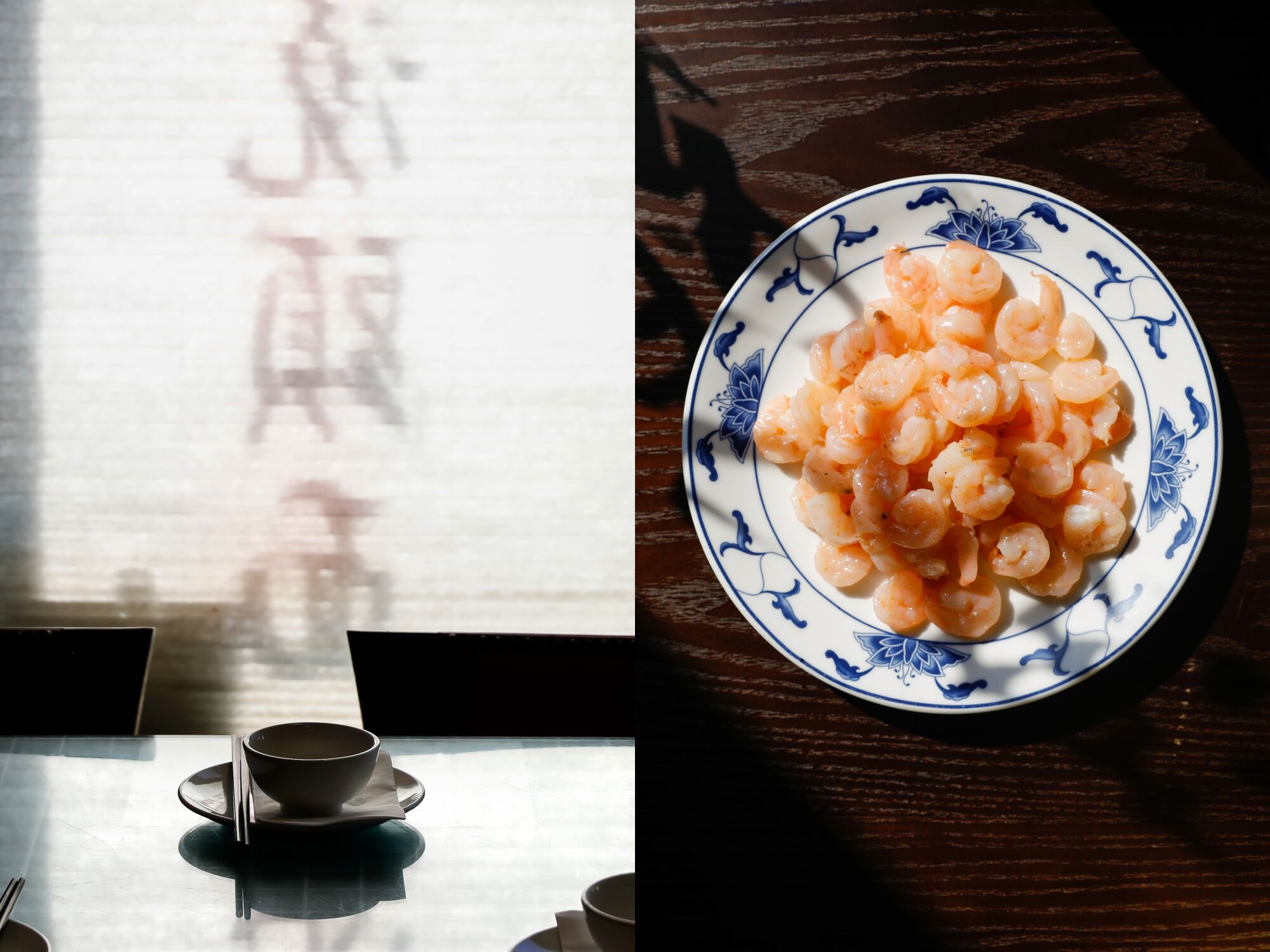The menu at WangJia in San Gabriel spans nearly 150 items. It can be an overwhelming document of stir-fries in dry, fiery or gently sauced styles; soup and noodle options by the dozens; and micro-surveys of several regional Chinese cuisines. Yet there is a shortcut to a focused, gratifying meal.
Lulu Luo, the owner of the 3-year-old restaurant, and her family are from Shanghai, and if you ask for guidance they’ll shine light on the dishes that taste most like home to them.
The cuisines of metropolitan Shanghai and the surrounding Jiangnan region — delineated by the Yangtze River Delta, a fertile area that also encompasses the culinary traditions of many neighboring smaller cities — never quite bask in the same spotlight afforded to the nuanced Sichuan firebrands that have dominated the San Gabriel Valley’s restaurant culture in the last decade, nor the Cantonese and Taiwanese standard-bearers that preceded them.
Recent meals at WangJia remind me that the varied, often subtle cooking of Shanghainese traditions have their place in the mix. My conversations with the staff around what to order always end with their one emphatic recommendation: xian rou cai fan, fried rice with salt pork and greens.

Lulu Luo, left, and Jack Ma, right, with their son Kevin Ma, center, at WangJia.
(Christina House / Los Angeles Times)
As with many sustaining comforts in the global canon, its ingredients number a handful and the technique is everything. Diced cubes of pork sizzle in a wok’s carbonized inferno, aided by a splash of oil or (more traditionally) lard. The variety of greens can vary. At WangJia the choice is tatsoi; its leaves soften in the heat more quickly than bok choy, a close brassica relative.
These two main ingredients enrich short-grained rice, precooked and tossed in the wok long enough to absorb its smoky exhalations. A few grains char here and there, but the texture as a whole remains fluffy rather than crisped. What’s most remarkable is the elegance of its seasoning: The rice tastes amplified, as if its pure, sweet flavor has been piped through the taste equivalent of surround sound, and the occasional bites of pork blare delicious bursts of salt.
No matter what else you’ve requested — a selection of the cold meats that are so much a part of the Shanghainese repertoire, variations on shrimp or eel specialties, the regional braised beef and pork signatures — the xian rou cai fan tends to arrive last on the table. Use clumps of it gripped in your chopsticks to capture stray bits of meat and to sop up rivulets of sauce on your plate. Eventually, though, like me you might find that the clear flavors of the rice dish satisfy entirely on their own.

Steamed pork buns at WangJia.
(Christina House / Los Angeles Times)

A table setting at WangJia Restaurant, left, their stir fry shrimp, right.
(Christina House / Los Angeles Times)
WangJia sits in the center of a strip mall, flanked by Bubble Republic tea shop on one side and D’ange bakery on the other. Luo took over the space, previously occupied by Q38 Noodle House, in 2019. Like many business owners, Luo relied on carryout and delivery to muddle through the impossible months of 2020 that she couldn’t have foreseen.
Two years later it’s hard to predict when the long, slim dining room with burgundy-colored walls will be filled and when it will be quiet, though the quality of the food has been consistent at recent meals regardless of the crowd.
If you’ve shown up with a group, consider settling in with a couple of cold appetizers: drunken chicken doused with nutty Huadiao wine, perhaps, or smoked fish whose network of tiny bones warrants the navigation for the meaty, campfire-sweet flavors. They come generously sized, so if you’re solo or in a pair, you may have plenty of leftovers.
You could just as easily go straight to the restaurant’s version of dongpo pork, one of the famous versions of the “red-braised” repertoire that turns everything in its path a shade of scarlet brown. Pork belly surrenders into tenderness while simmering in wine, soy sauce, spices and sugar. Often meat is served over a steamed vegetable; WangJia instead merges the pork into a trio with chewy-soft squid and willowy, threadlike tea tree mushrooms. Every mouthful brings a fresh study in textures.
Lion’s head meatballs, another defining pork dish, comes in its most classical form: several coarse, enormous orbs, the meat coarsely chopped yet utterly lush, draped in cabbage leaves and bathed in a brothy, lightly thickened sauce. Dialed-back, gingery spicing reinforces the dish’s remarkable lightness.
Among soups, I’m partial to the cloudy, poultry-intense stock of the duck noodle soup bobbing with just-crisp bamboo shoots. Another one features a tureen full of pickled cabbage and delicate threads of lamb; the star ingredients tangle nicely in bright, gamy bites, though the broth has less overall depth.
Yan du xian — a Shanghai staple of salt pork and uncured pork belly, greens and sheets of tofu skin tied into twisty knots — appears on WangJia’s menu in English as “Shanghai salty pork soup.” It, too, has a wan broth, and it made me think of the richer, superior rendition at Jiang Nan Spring, another Shanghainese specialist, five blocks away. That said, I favor the dongpo pork at WangJia; both places should be on the map for their best dishes.
Tiny, crystalline shrimp stir-fried with longjing — the prized, nutty-vegetal green tea, also known as Dragonwell, whose leaves are plucked in spring when they’re still razor-thin buds — is another regional essential, and it’s hard to find in the United States. WangJia makes the dish minus the longjing. It might arguably veer into too subtle for some palates. I like the glassy snap of the nearly unadorned shrimp, and I follow the lead of my Chinese friends who eat portions of xian rou cai fan in small bowls after they’ve finished their soup and dot the shrimp on top.

For an immersive, full-throttle finale, look to the whole crab in a sauce that tastes wonderfully of crab roe.
(Christina House / Los Angeles Times)
For an immersive, full-throttle finale, look to the whole crab dissected and nearly submerged in a sauce that tastes wonderfully of crab roe. Chao nian gao (thin, slippery, oval rice cakes) also slide around the bowl. You’ll eat it all half with chopsticks and half with your hands, sauce joyfully everywhere; it’s worth asking for a tool to help crack the crab.
I should probably let you know that the sprawling menu includes a robust section of Sichuan dishes. Luo’s son Kevin Ma mentioned one meal that they carried over from previous restaurant incarnations in the space and said the Asian clientele orders it regularly.
One of these days I’ll wind around to the restaurant’s fish in hot chile oil, or pepper beef, or fried chicken riddled with Sichuan peppercorns. There’s a line in “Land of Fish and Rice,” author Fuschia Dunlop’s book on the cooking of Shanghai and its surrounding provinces, that has always resonated: “A good Jiangnan meal should leave a person feeling shu fu — comfortable and well.” That holds true for me at WangJia, and until I’ve finished quizzing Luo and Ma on the dishes of their region I’ve yet to try, I’ll be following their suggestions.
WangJia
800 W. Las Tunas Drive, San Gabriel, (626) 872-0618, wangjiarestaurant.com
Prices: Soups $11.99-$26.99; dumplings, noodles and fried rice $5.99-$14.99; most entree-sized dishes $11.99-$35.99.
Details: Open daily, 11 a.m.-8:30 p.m. No alcohol. Street and lot parking. Takeout available.
Recommended dishes: Xian rou cai fan (on the menu as “salty pork and vegetable with rice”), crab with rice cakes, stewed duck soup, stewed pork and squid with tea tree mushrooms, lion’s head meatballs.
Stay connected with us on social media platform for instant update click here to join our Twitter, & Facebook
We are now on Telegram. Click here to join our channel (@TechiUpdate) and stay updated with the latest Technology headlines.
For all the latest Food and Drinks News Click Here
